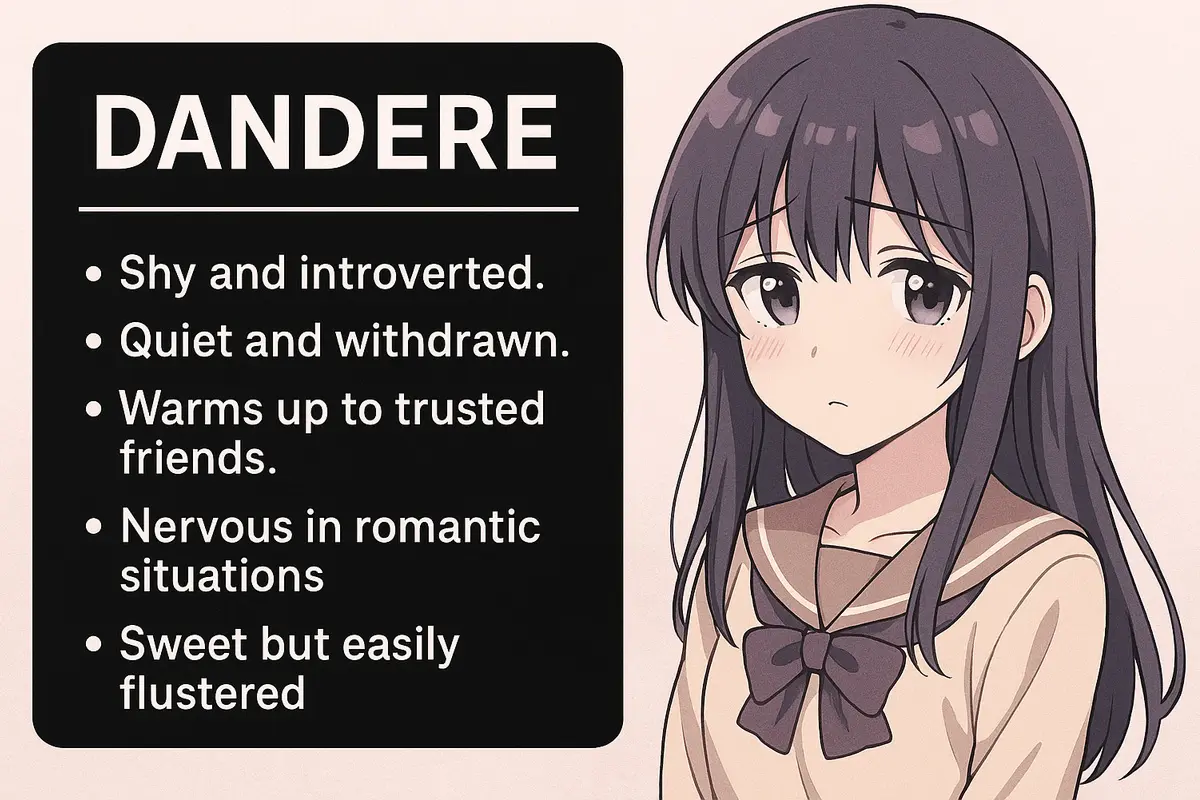
Dandere Meaning
Dandere is an anime and manga term for a very shy, quiet character who struggles to speak up in public, but becomes warm, sweet, and affectionate once they feel safe with someone they trust.
In one line: a Dandere is “silent in public, soft in private.”
Dandere meaning (quick definition box)
A Dandere character usually:
- avoids attention and crowds
- speaks softly (or barely speaks at all)
- feels awkward in social situations
- shows love through small, private gestures
- opens up slowly, then becomes loyal and caring
If you searched for “dandere meaning,” this is the simplest definition.
Meaning and origin of “Dandere”
The word Dandere (ダンデレ) combines:
- Danmari (黙り) – “silent / reticent”
- Dere-dere (デレデレ) – “lovey-dovey / affectionate”
Put together, it describes someone who seems quiet and withdrawn at first, but becomes sweet once they’re comfortable.
Core traits of a Dandere
Dandere characters don’t win you over with loud lines or dramatic speeches. They win through quiet sincerity and slow character growth.
- Shy and introverted – avoids eye contact, attention, and big social settings.
- Soft-spoken – speaks quietly, hesitates, and often stumbles over words.
- Socially reserved – feels safest in one-on-one moments with someone trusted.
- Hidden warmth – once they open up, they can be surprisingly caring and loyal.
- Easily flustered – blushes and panics easily in romance or praise moments.
💡 Tip: Dandere is shy/awkward. Kuudere is calm/controlled. Yandere is sweet/obsessive.
Dandere vs. other “dere” types
| Archetype | Personality traits | How they show affection |
|---|---|---|
| Dandere | Shy, hesitant, quiet | Small, private gestures |
| Kuudere | Calm, stoic, guarded | Subtle warmth, rare emotional moments |
| Tsundere | Hot-and-cold, defensive | Swings between harsh and sweet |
| Yandere | Loving but obsessive | Can become extreme or controlling |
Why fans love Dandere characters
- Relatable shyness – many viewers see themselves in them
- Character growth – slow opening-up arcs feel rewarding
- Emotional payoff – when they speak up, it matters
- Protective instincts – audiences want them supported and understood
Popular Dandere characters in anime
- Hinata Hyuga (Naruto) – shy, kind, quietly strong
- Mikuru Asahina (The Melancholy of Haruhi Suzumiya) – timid, gentle
- Nagisa Furukawa (Clannad) – soft-spoken, grows through love and friendship
- Kosaki Onodera (Nisekoi) – sweet, shy, emotionally sincere
(Characters can be “dandere-adjacent,” so lists vary by fan interpretation.)
Common story roles for Dandere characters
- Slow-burn love interest
- Quiet emotional support
- Nervous comic relief
- Hidden strength reveal
How to spot a Dandere in anime
- hesitates before speaking
- avoids crowds
- acts different in private vs. public
- shows kindness through actions more than words
- blushes easily when noticed
FAQ: Dandere meaning and related questions
What does dandere mean?
Dandere means an anime character type who is very shy and quiet in public, but becomes warm and affectionate once they trust someone.
Is dandere the same as kuudere?
No. Dandere is quiet from shyness or social anxiety. Kuudere is quiet from calm control or emotional guard.
Is dandere the same as introvert?
Not exactly. Dandere is a fandom label for a specific anime pattern, not a real personality category.
Can a dandere be a love interest?
Yes. Dandere characters are commonly written as slow-burn love interests.
What’s the difference between dandere and tsundere?
Tsundere is hot-and-cold and may act rude before turning sweet. Dandere is not mean—just shy and quiet until they open up.
Is dandere a real psychology term?
No. It’s an anime/fandom term, not a clinical concept.